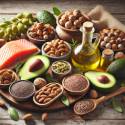
Our product evaluations are completely independent and free from advertisements. Should you make a purchase via the links on our website, we might receive a small commission, which is a key support for our review process. For more details, click here.
The Mediterranean Diet is often recommended by doctors and nutritionists. It’s said to be one of the healthiest, and it’s also one of the few popular diets that can draw upon decades of research—it’s how they eat in the Med, after all.
It’s one I follow myself, and in this guide, I’ll discuss the reasons why I think more people should adopt this diet, along with the benefits, and the ways it can be combined with other top dietary choices.
Mediterranean Diet: Overview and Personal Opinions
I’ve tried my fair share of diets over the years, from detoxes and cleanses to many weight-loss diets. Some are too restrictive and difficult to maintain, and some require too many drastic changes in my usual routine. But the Mediterranean Diet is a different beast altogether. It’s not limiting, it doesn’t require prolonged periods of abstinence or fasting, and more importantly, it’s easy to incorporate into other diets, including intermittent fasting.
It also works! I can attest to that. It might not be as effective as some other options with regard to weight loss, but it can be adjusted to suit those needs. And that’s not really the main goal. If you stick with Mediterranean Diet staples (fresh fruits/vegetables, fish, minimal red meat), it can promote overall health and wellbeing.
The Key Principles of the Mediterranean Diet
As the name suggests, the Mediterranean Diet is based on the diet of people living around the Mediterranean, including countries like Spain, Italy, and Greece. These countries have some of the best cuisines in the world, but they also have low rates of heart disease largely attributed to their diet.
MedDiet Food Pyramid
The MedDiet food pyramid prioritizes fresh produce and limits consumption of desserts/desserts, meat, and dairy, while emphasizing the importance of fresh, unprocessed food:
Foods for Every Meal
- Whole grains
- Vegetables
- Fruit
- Extra virgin oil
Foods to Eat at Least Three Times a Week
- Legumes
- Fish
- Nuts
Foods to Eat No More Than Once a Day

- Dairy (usually low-fat cheese or yogurt)
- Eggs
- Poultry
Foods to Eat No More Than Once a Week
- Red meat
- Sweets
Pros and Cons
Pros of the MedDiet
- Could reduce the risk of heart disease
- Doesn’t require extreme low-fat or low-carb eating
- Allows for occasional sweets and alcohol
- Good for the environment
- Could help with weight loss
Cons of the MedDiet
- Limits red meat intake
- May not be suitable for people with certain health conditions
Mediterranean Diet Shopping List
The reliance on fresh produce means you may need to make regular trips to the grocery store, but there are a lot of Mediterranean Diet staples you can buy in bulk and keep in your pantry. For me, a grocery list for the Mediterranean Diet usually looks something like this:
- Extra virgin olive oil (I buy in bulk, as it’s one of the most common ingredients)
- Feta
- Fresh fruit and veg (opt for whatever is in season)
- Whole grain bread
- Whole grain pasta
- Chicken/turkey
- Fatty fish
- Beans
- Peas
- Lentils
- Greek yogurt
- Nuts
- Red wine
Canned beans and tomatoes are good to have in your pantry, along with dried pasta, flour, and lentils.
What to Avoid on the Mediterranean Diet
The MedDiet is about eating fresh and healthy meals full of nutrients, complex carbs, fiber, protein, and healthy fats. Some of the things you should avoid include:

- Processed food
- Excessive red meat
- Butter and animal fat
- Desserts and candies
- Soda and high-sugar fruit juices
- Lots of alcohol (a little red wine is fine)
The Benefits of the Mediterranean Diet
One of the primary benefits of the MedDiet is that it can reduce the risk of heart disease. It makes sense, as it combines all the elements known to protect the heart and improve overall health:
- Low in saturated fat
- Low in heavily processed foods
- Low in salt and sugar
- High in healthy fats (monounsaturated and polyunsaturated)
- High in protein
- High in essential nutrients
It’s for this reason that the diet is often voted as the healthiest. I personally like to go the extra mile and live like a Mediterranean as well. Red wine is my drink of choice (in moderation, of course), and I try to eat as many meals as possible with family and friends.
This communal eating aspect is thought to add to the diet’s benefits. It seems strange at first, but not when you pick it apart.
Think about how you eat with friends and loved ones compared to how you eat alone. If it’s just you, not only are you more likely to opt for convenient meals, but you also eat quickly, not giving your body time to tell your brain that it’s full. You don’t drink as much or take as many breaks between mouthfuls, so digestion may be impacted, as well.
Conversely, if you’re eating with others, you’re more likely to cook and focus on balanced meals. You also take the time to chat and are less likely to spend mealtimes hunched over your plate wolfing the food down (I’ve been there!).
It’s also good to socialize every now and then, and being able to chat with others provides a mental boost, which in turn could help with all aspects of health.
So, if you have others in your household, invite them around the table and cook a big meal at least once a day. Rather than piling the food on their plates and handing them out like a server at a restaurant, place bowls of salad, sides, and whatever else you’re eating in the middle of the table and let them help themselves.
Is Fat Not a Problem?
For a long time, we were led to believe that fat was the devil and that we should abstain at all costs. Unfortunately, this seems to have contributed to the Western obsession with sugar, as fat creates flavor, and when you take that away, you need something to replace it.

But not all fat is bad. Sure, it’s more calorific, and too much isn’t good for you. But the MedDiet is high in monounsaturated and polyunsaturated fats, which are good for the body and the brain and have the same effects as saturated fat.
The main fat in the MedDiet comes from extra virgin olive oil, which is very good for you. They tend not to cook with refined seed oils and vegetable oils, they don’t use much animal fat, and while they do consume a little cheese and yogurt, it’s always low-fat alternatives like feta and Greek yogurt.
If you’re dieting and worried about fat consumption, just monitor your calories using an app like MyFitnessPal or Cronometer. They will help you to stay under your allowance for the day, and that should ensure you drop a few pounds while also getting all of the other benefits of the Mediterranean Diet.
Sample Mediterranean Diet Meal Plan
Meal prep on the Mediterranean Diet is easy, as it incorporates a wide range of recipes to suit all tastes. See below for some ideas to get started, but remember there are many more out there, and there’s nothing to stop you from getting creative and conjuring up some healthy meals of your own (there are also plenty of Mediterranean Diet books to help you):
Mediterranean Diet Breakfast Recipes
- Strapatsada: A simple Greek breakfast dish made with eggs, feta, and tomatoes. It’s hard to get this wrong. Just add oil to a pan and throw in some chopped tomatoes (canned tomatoes are good, too). Mush the tomatoes while stirring, crack in a couple of eggs, and then take off the heat when they are cooked. Finish with some crumbled feta and chopped basil.
- Oatmeal: A little honey, some cinnamon, and chopped dates/dried figs make for a great morning meal. Add pine nuts or chopped walnuts/pecans for some bite.
- Omelet: Make an omelet with whatever veg you can find, including peppers, tomatoes, and avocados. Add a sprinkle of feta and herbs to finish.
- Smoothie Ball: My favorite fruity start to the day! I make mine by combining blueberries and strawberries (or whatever berries I can find) with a little honey and lots of Greek yogurt, before topping with frozen blueberries and a sprinkle of chopped nuts.
Mediterranean Diet Dinner Recipes
- Fakes: Pronounced “fa-kess”, this Greek dish uses brown lentils, tomato puree, carrots, and potatoes, as well as lots of oil and vinegar. Begin by browning some onion and garlic while boiling the lentils. Add carrots, cook until soft, and then add the lentils with water, bay leaves, tomato paste, oregano, and rosemary. Cook until the lentils are soft, and serve with bread.
- Tomato and Feta Pasta: This is an easy one. Simply throw some tomatoes in the oven with a chunk of feta, cook until soft, and then stir into cooked pasta with salt, pepper, and oregano. Add other roasted vegetables to get more nutrients.
- Chicken, Potatoes, and Salad: A simple but delicious dish. Chop potatoes and chicken, place in a baking dish with oil, garlic, and oregano, and cook until soft. Serve with a Greek salad (cucumber, feta, tomatoes, and olives cut into chunks and mixed with oil, vinegar, and dill).
Mediterranean Diet Snacks
Nuts are a great snack, as is Greek yogurt. If you’re counting calories, slice some cucumber and sprinkle a little salt on top. It sounds simple, but trust me, it’s amazing!
Fruit is always a good option, too, whether it’s a big wedge of watermelon, an orange, or a handful of berries.
Just don’t reach for those chips and candies. Stay away from the processed stuff!
Mediterranean Diet Desserts
There are some decadent desserts in the Med, and these are OK in moderation (once a week, not once per day). Baklava is a great example, but it’s very rich and calorific. Instead, make friends with Greek yogurt. It’s low in fat and sugar and tastes amazing with a little fruit, honey, and nuts.
How to Combine the MedDiet With Other Diets
As noted at the top of this article, you can combine the MedDiet with other diets, provided they don’t focus too heavily on specific food groups (as with the carnivore diet).
Gluten-Free
The Mediterranean Diet is typically very high in whole wheat and grains. It’s one of the main components, so eating a gluten-free Mediterranean Diet requires a little planning:
- Switch wheat pasta for gluten-free alternatives (such as lentil pasta)
- Omit bread or look for alternatives
- Add more oats to your diet
- Increase your intake of fruits, vegetables, and legumes
Fasting
With intermittent fasting, it doesn’t really matter what you eat as long as you eat within specific windows. This is true whether you’re following a 16/8 fast (16 hours of eating and 8 hours of fasting every day) or a 5:2 (two days eating a quarter of your recommended calories; 5 eating normally).
Following a Mediterranean Diet on non-fasting days and in non-fasting windows may help you to get your fill of essential nutrients and prevent you from binging on high-energy, processed foods.
Plant-Based
Switching to a Mediterranean vegetarian diet or vegan diet doesn’t just mean adding more vegetables to your diet. You also need to think about your protein sources. Add more leafy greens, legumes, and beans.
There’s nothing wrong with the occasional meat substitute, either, but bear in mind that these are often heavily processed. While they tend to be marketed as healthier alternatives, they can still be high in saturated fat and other additives that aren’t too common in the MedDiet.
Weight-Loss Programs
I mentioned that the main goal of the MedDiet is not to lose weight. That certainly wasn’t the reason I tried it. But it’s easy to transition. Simply reduce your calories and exercise more.
If your current diet is high in processed foods, the transition may be easier than you think. Once you swap all that sugar, salt, and saturated fat for fresh produce, you’ll feel fuller throughout the day and should have fewer issues with bloating. This could be enough to motivate you to exercise while also allowing for easier digestion. As a result, you don’t even have to drop too many calories from your daily allowance to notice a difference.

Strength Training/Bodybuilding
Red meats and dairy aren’t excluded from the MedDiet, but they aren’t consumed in high quantities, either. Rather than chugging protein shakes and eating large portions of meat with every meal, eat more protein-rich vegetables like peas and split peas. Eat lean meat and fish, and swap fatty cheeses for a little feta and Greek yogurt.
FAQs
Summary: Following the Mediterranean Diet
In 2024, US News ranked the Mediterranean Diet as the “healthiest diet” in the world for the seventh straight year. The best thing about this diet is that it wasn’t conjured up by an author with a unique take on nutrition. There are books on the Mediterranean Diet, but they draw straight from communities around the Med, ones that have been eating this way for generations.
It doesn’t require extreme abstinence. It doesn’t focus on a single food group. And there is no fasting. At the same time, however, its focus on fresh produce, communal eating, and minimal red meat is the polar opposite of the modern Western diet, one that has become heavily reliant on dairy, meat, and processed foods.
So, it can be difficult for some people to make the switch. But we live in an age where you can order any kind of fresh produce right to your door, and if that’s too much hassle, there are countless meal delivery Mediterranean Diet services that do the hard work for you.
It’s a diet that I have followed for a long time (admittedly, some weeks more stringently than others), and one that I have combined with weight-loss regimes and plant-based diets. It works. It’s healthy. More importantly, you don’t have to give up delicious food!
Just think of all those delicious Mediterranean Diet breakfasts, dinners, and desserts, and tell me you’re not intrigued!